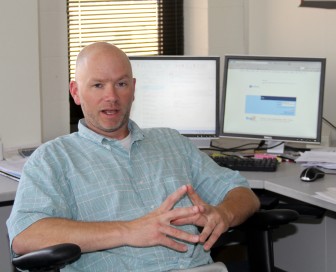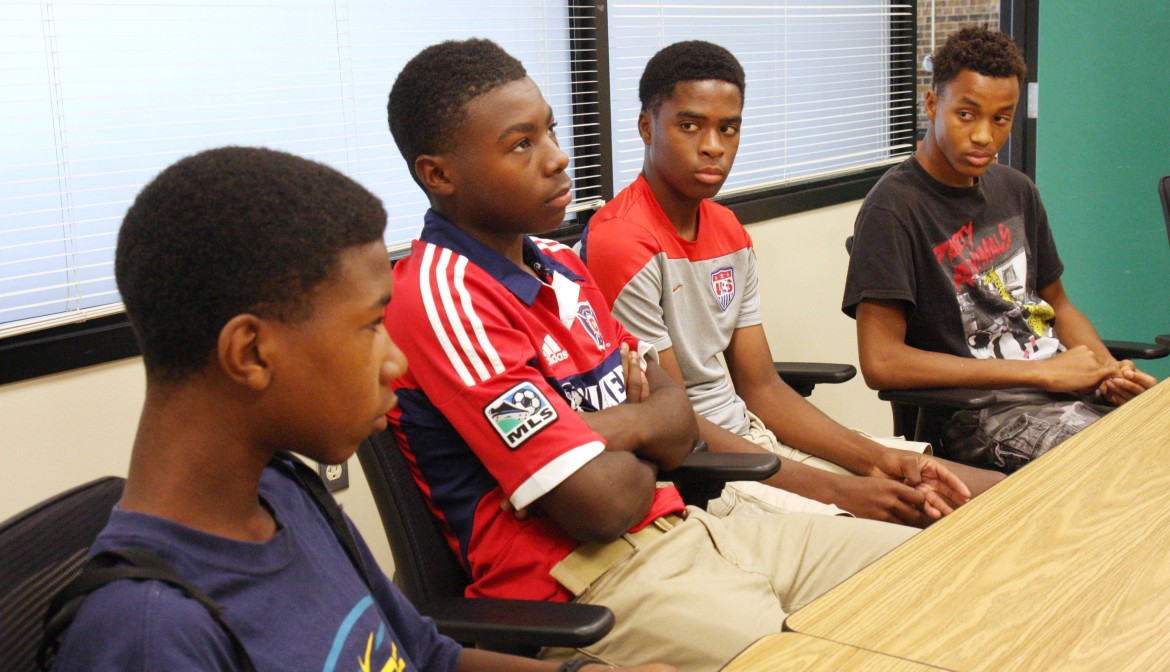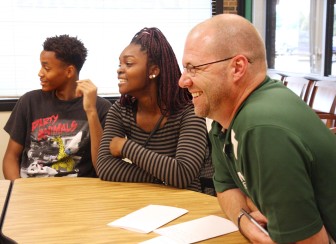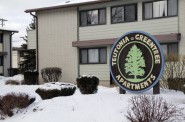State Has Worst Black-White Learning Gap
Despite decades of efforts to close gap, little improvement has occurred.
Wisconsin ‘worst’ for black children
Black students in Wisconsin are more likely to come to school hungry, abused or neglected — proven roadblocks to academic success. In fact, the 2014 Wisconsin Council on Children and Families report Race for Results labeled Wisconsin as the worst state for black children to live. In a comparison of 46 states, Wisconsin’s black residents ranked as the worst in four of 12 indicators including delayed childbearing, young adults who are in school or working, children who live in two-parent households, and adults who have completed at least an associate’s degree, the report found. As of 2014, 49 percent of Wisconsin’s black children were living in poverty, compared to 11 percent of white children, according to data compiled by the Annie E. Casey Foundation’s Kids Count project. Although Evers said no state is making strides in narrowing racial achievement gaps, Ohio did shrink the gap in fourth-grade reading, according to the 2015 Nation’s Report Card data cited by Peggy Carr, acting commissioner for the National Center for Education Statistics. Carr added, however, there were no other signs of narrowing the gap elsewhere. Wisconsin’s high suspension rate of black students is another barrier to their success in the classroom.

Bradley Carl, a University of Wisconsin-Madison education researcher, says there is little data on programs proven to narrow racial achievement gaps. He says that is one of the reasons for the state’s persistent racial disparities in school performance. Photo by Abigail Becker of the Wisconsin Center for Investigative Journalism.
A report from the Civil Rights Project at the University of California-Los Angeles found that Wisconsin tops the nation in suspension rates, disciplining 34 percent of black high school students. The state has a 4 percent suspension rate for white students — the largest black-white discipline gap of all 50 states at the high school level, according to the report. Wisconsin’s suspension rate for black elementary students is the second-highest at 12 percent, the report found. “If we ignore the discipline gap, we will be unable to close the achievement gap,” the report’s authors write. Researchers and policymakers disagree about whether there have been successful efforts in Wisconsin to narrow the racial gap. While DPI has compiled dozens of examples of programs in Wisconsin that it says are working, UW-Madison education researcher Bradley Carl said he has yet to find any program “that has moved the needle on (the achievement gap)” in a big way. University and state researchers will have the opportunity to find and analyze the practices across the state that are working to close the achievement gap with a $5.2 million U.S. Department of Education grant — the largest research collaboration yet between DPI and UW-Madison.
Gap large at ‘microcosm’ school
Despite high achievers such as Kigeya and Lassey, a racial chasm in academic achievement persists at Madison Memorial High School. The school describes itself as a “microcosm” of Madison, drawing its students from neighborhoods ranging from subsidized apartments to upper-middle-class subdivisions. Just over half of its 1,917 students are white, 35 percent are low-income and nearly 20 percent are black.

From left, Memorial High School students William Lemkuil, Demitrius Kigeya, Odoi Lassey and Robert Bennett say they face racial stereotypes at school. Photo by Joseph W. Jackson III of the Wisconsin Center for Investigative Journalism.
In the 2013-14 school year, about 9 percent of Memorial’s black students tested proficient in math and 13 percent in reading, compared to 46 percent of white students in math and 51 percent in reading. Affeldt said one problem is minority students often come into school believing they are not going to be successful because of racial stereotypes. “It’s hard for me to hear students who feel that they can tell when they’re out in the community that it’s just sort of an assumption they’re not successful in school even though they are,” Affeldt said.

Madison Memorial High School Principal Jay Affeldt, right, says stereotyping can hurt student performance. Affeldt graduated from Memorial in 1991, returned as a teacher in 1999 and is now in his second year as principal. Affeldt joined students Robert Bennett and Geresa Homesly in a roundtable discussion on race-based achievement gaps. Photo by Joseph W. Jackson III of the Wisconsin Center for Investigative Journalism.
Kigeya and sophomore William Lemkuil agreed, and described feeling like they do not belong in their own predominantly white neighborhoods. “Cars will drive past giving me weird looks like ‘Why are you here?’, like ‘How did you get here?’” Lemkuil said. William’s mom, Amy Lemkuil, is thinking ahead to when William is 16 and getting a driver’s license. She does not want William, whom they adopted as a baby, to drive the rusted old family car dubbed “Black Beauty” that his white older sisters drove because “I don’t want him to be stereotyped.” Experts agree that any solutions to Wisconsin’s black-white achievement gap must include Milwaukee Public Schools, which house half of all black students in the state. Milwaukee’s public schools are located in one of the most highly segregated cities in the country and reflect the racial disparities of a city with a child poverty rate of 42 percent — more than twice the state average, according to 2014 Kids Count data. Half of all black students in Wisconsin attend Milwaukee Public Schools. In 2014-15, black students numbered 42,232, making up about 55 percent of the district’s student body. In the 2013-14 school year, 10 percent of black students in Milwaukee were considered proficient in math and 8 percent in reading, compared to 35 percent of white students in math and 30 percent in reading.
Gaps all over state
Black students in school districts from Madison to Kenosha and Green Bay to Racine also graduate at much lower rates than their white peers. The graduation rates of black students in some districts such as Beloit and Racine have improved in recent years. But Green Bay saw a big drop in the graduation rate of its black students, from about 57 percent in 2012-13 to 44 percent in 2013-14. There are places where black students are not so far behind. In the Beloit School District, 85 percent of black students graduate from high school, compared to 90 percent of whites. Tasha Bell, the district’s equity coordinator, said Beloit, which ranks 18th in size among Wisconsin school districts, has the diversity but not the size of a large urban district. It has 1,591 black students making up 22 percent of its 7,133-member student body. Among the strategies Bell uses to encourage minority students to aim high is hosting a minority scholars reception each year for students of color who have at least a 3.5 cumulative grade-point average. Bell said the event helps minority students who do well in school see they are not alone. “(It’s) a celebration of students of color working toward that achievement gap, defying the odds that we know exist in terms of the gaps and where they are,” Bell said. There are other signs of positive movement in Wisconsin. The statewide four-year graduation rate and the graduation rate among black students have both increased in recent years, although racial gaps are still striking. Across the state, the black student graduation rate rose from 61 percent in 2009-10 to 65 percent in the 2013-14 school year. White students’ graduation rate increased from 91 to 93 percent in that same time. The five- and six-year graduation rates are also increasing across the board and for black students.
Chasm wide, persistent
Over the past two decades, while the nationwide gap between the races has narrowed, the disparity in Wisconsin has not, according to The Nation’s Report Card test results.
In 1996, the gap between the average math scores of black and white eighth-grade Wisconsin students was the largest among participating states at 48 points; the national gap at the time was 39 points.
Fast forward to 2015. According to the most recent Nation’s Report Card scores, Wisconsin blacks and whites were still separated by 48 points in math. Nationally, the gap for the same age and subject was 31 points.
It is not just that the state’s students on average perform so well. Wisconsin’s black students scored below the national average for black students in all four categories in 2015. For example, among fourth graders, Wisconsin’s black students scored 193 in reading compared to a national average among black students of 206.
Disparity sparks public debate
Wisconsin’s achievement gap is on the public’s radar. Last year, the activist group Justified Anger created a plan to address Madison’s disparities. Evers formed a statewide task force of educators and others to highlight schools that are closing the achievement gap. And a top Republican lawmaker has created the Speaker’s Task Force on Urban Education.
Assembly Speaker Robin Vos, R-Rochester, formed the group in August to “provide tangible solutions to help improve educational outcomes” in schools serving high-poverty urban areas.
To date, the task force has toured schools in Madison, Racine, Kenosha and Green Bay and held meetings on mental health, behavior problems and truancy, and improving teacher recruitment and retention.
The task force was the first time educators from schools that are closing gaps came together from around the state and discussed concrete solutions for making statewide improvement, said Demond Means, the Mequon-Thiensville School District superintendent who chaired the task force.
“When people talk about the achievement gap … there isn’t any substance in terms of what you can do to close it,” he said. “We were able to show support from research and then give strategies that people can implement immediately.”
In November, Means was appointed to lead a Milwaukee turnaround district mandated by the Legislature. He told the Milwaukee Journal Sentinel that he will work with district officials to close the achievement gap, which he calls the “civil rights movement of the 21st century.”
Gloria Ladson-Billings, a professor in UW-Madison’s School of Education, echoed those sentiments at a panel Nov. 5 sponsored by Madison’s Simpson Street Free Press. She said calling it a “nagging achievement gap” does not do it justice.
“We’re in crisis,” Ladson-Billings said. “It is not nagging, it is persistent, it is structural. We’re at a point where we cannot go failing another generation of people.”
Children Left Behind
-
Study Shows Poverty’s Impact on Kids
 Jul 9th, 2016 by Abigail Becker
Jul 9th, 2016 by Abigail Becker
-
Teaching Poor Kids Where They Live
 Feb 18th, 2016 by Abigail Becker
Feb 18th, 2016 by Abigail Becker
-
Wisconsin Going Backwards on Achievement Gap
 Dec 21st, 2015 by Abigail Becker
Dec 21st, 2015 by Abigail Becker

















The schools aren’t to blame .. Relatively speaking, Wisconsin has higher than average performing whites and lower than average performing minorities. As a whole, the white family structures are stronger and more dedicated to education — and more segregated — resulting in higher performance versus others.
No surprise there’s a big gap.